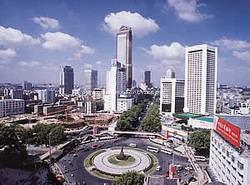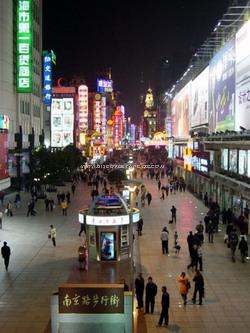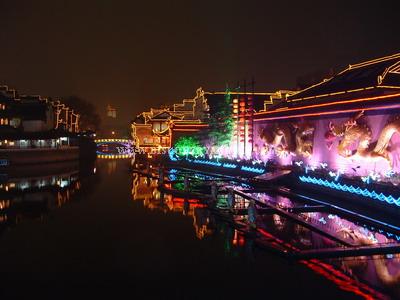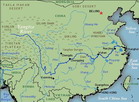2020 Yangtze River Cruise and Ferry Starting from 79 USD p.p.!
Nanjing Introduction
Nanjing-'Southern Capital'--along with Luoyang, Xi'an and Bejing, is one of the historical
 capitals of China, and the many imperial tombs and architectural remains in the city and its environs reflect its grandiose past. Today, the city is the capital of Jiangsu Province. Its industries include machine-building, automobile assembly,electronics, petroleum, iron and steel, textiles, shipbuilding and foodstuffs. A double-tiered road and rail bridge, completed in 1968, spans the Yangtze at Nanjing.
capitals of China, and the many imperial tombs and architectural remains in the city and its environs reflect its grandiose past. Today, the city is the capital of Jiangsu Province. Its industries include machine-building, automobile assembly,electronics, petroleum, iron and steel, textiles, shipbuilding and foodstuffs. A double-tiered road and rail bridge, completed in 1968, spans the Yangtze at Nanjing.There is a visible military presence in Nanjing. Soldiers may approach you and gesture to not take photographs of that location. Many buildings and compounds in Nanjing are military areas and are not open to the public.
HlSTORY OF NANJING
With the Yangtze on one side, and surrounded on the other three sides by hills,Nanjing was thought to be auspicious as well as strategically important. First historical records date from the Spring and Autumn period (770--476 BC) when the area was divided between the Kingdoms of Wu, Yue and Chu. A walled town was built during the Eastern Han period (AD 25--220), known as 'Stone City'.
Between the third and l4th centuries, eight dynasties established their capitals in the city,
 some of them building magnificent palaces and forts. Though many of these minor dynasties had incompetent rulers and regimes weakened by intrigue and debauchery, Nanjing emerged as a cultural centre of painting, philosophy and Buddhism. In the sixth century, the Sui dynasty established its capital at Xi'an, and ordered the complete destruction of earlier dynastic buildings in Nanjing.
some of them building magnificent palaces and forts. Though many of these minor dynasties had incompetent rulers and regimes weakened by intrigue and debauchery, Nanjing emerged as a cultural centre of painting, philosophy and Buddhism. In the sixth century, the Sui dynasty established its capital at Xi'an, and ordered the complete destruction of earlier dynastic buildings in Nanjing. The city flourished again during the Tang dynasty (618--907), when the great poets Li Bai, BaiJuyi and Liu Yuxi lived here for a while. For a brief period, Nanjing (then called Jinling) became the capital of the Southern Song, but the dynastic base had to be moved to Hangzhou as the pursuing Nuzhen Tartar armies advanced.Marco Polo may have visited the city in 1275.
The founder of the Ming dynasty, HongWu(Zhu Yuan Zhang), captured Nanjing in 1356 and set up his capital here, building palaces, temples and pagodas. (The famous green- and white-glazed-tile Porcelain Pagoda of the Bao'en Temple, so often praised as one of the seven wonders of the world by earlier travellers, belonged to this period, though it was totally destroyed during the Taiping Rebellion (1850--64).Some of its tiles are on exhibition at the Chaotian Gong.) He also enlarged the city wall to make it the longest in the world. Earlier Tang-dynasty poets had written lyrically of being entertained on 'singsong boats'--sort of floating bordello-long the Qinhuai (a ten-kilometre, or six-mile, man-made river, said to have been dug during the second century BC, skirting the western and southern edges of Nanjing). A picture of more innocent pleasures is conjured up by a passage from The Scholars, an early l8th-century novel by Wu Ching-tzu:
After the middle of the fourth month in Nanking, the Chin-huai River becomes quite lovely. The barges from other tributaries of the Yangtze dismantle their cabins, set up awnings, and paddle into the river. Each vessel carries a small, square, gilt-lacquered table, set with an Yihsing stoneware pot, cups of the finest Cheng Hua or Hsuan Te porcelain, and the choicest tea brewed with rain water. Boating parties bring wine, dishes and sweet meats with them to the canal, and even people travelling by boat order a few cents' worth of good tea to drink on board as they proceed slowly on their way. At dusk two bright horn lanterns on each vessel are reflected in the water as the barges ply to and fro, so that above and below are bright. Fluting and singing are heard all night and every night from Literary Virtue Bridge to Lucky Crossing Bridge and East Water Guardhouse. The pleasure-goers buy water-rat fireworks too, which project from the water and look like pear trees in blossom when let off. The fun goes on till the fourth watch each night.
Translated by Yang Hsien-yi and Gladys Yang
During the Ming dynasty (1368--1644), an imperial decree established a special government
 department to oversee brothels Which catered to the 200,000 garrisoned troops in the city. The capital was moved to Bejing in 1420, but Nanjing remained a subsidiary capital and financial centre. In the Qing dynasty (1644--1911) also troops were garrisoned in the city.
department to oversee brothels Which catered to the 200,000 garrisoned troops in the city. The capital was moved to Bejing in 1420, but Nanjing remained a subsidiary capital and financial centre. In the Qing dynasty (1644--1911) also troops were garrisoned in the city.The Treaty of Nanking (Nanjing) ending the Opium War of (1839--1842) was signed aboard HMS Cornwallis between the British and the Chinese. It ceded the territory of Hong Kong to Britain, opened five Chinese ports to foreign trade, and exacted a payment of 21 million Mexican dollars as indemnity from the Chinese. It was the first of what became known as the Unequal Treaties. The pseudo-Christian Taiping Rebellion made its headquarters in Nanjing in l853 and occupied it for 11 years. Its leader, Hong Xinquan, adopted the title 'Heavenly King' and appointed other leaders as Princes of the East, West, North and South'. The 'Heavenly King built a large palace of which little now remains. The city was almost completely destroyed in the devastation and killings that followed the overthrow of this rebellion. Nanjing became a treaty port under the terms of the 1876 Chefoo (Yantai) Convention.
Followillg the revolution of 1911, Nanjing was declared the capital of the Republic of China in 1912. (Dr Sun Yat-sen, founder of the Nationalist Republic, was buried here in 1929.) The Nationalists regained control over Nanjing from the local warlord in 1926, and it remained the capital until just before the Japanese occupation of the city in l937, When an estimated 400,000 residents perished in what became known as the 'Rape of Nanjing. In early 1949 the People's Liberation Army entered Nanjing, driving the Nationalist government, the Guomindang, before it, first to GuangZhou and then to Taiwan.
• Nanjing and Its History
• What to see in Nanjing (1): Sights Within The City
• What to see in Nanjing (2): Sights Within The City
• What to see in Nanjing (3): Sights Outside The City Centre
• What to see in Nanjing (4): Sights Outside The City Centre
• What to see in Nanjing (5): Sights South & East of Nanjing



